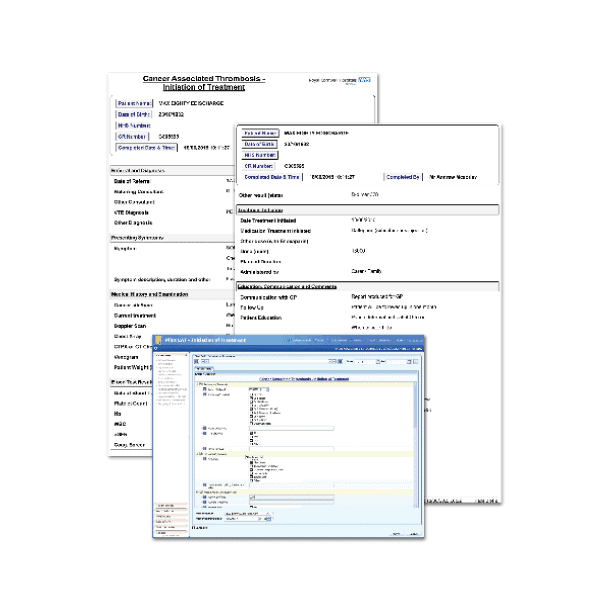Summary
Building on the Integrated Care Pathway (ICP) for patients with cancer associated thrombosis (CAT) published in 2013, this initiative transferred the pathway’s treatment milestones from its proposed paper format into the electronic patient record. The use of the electronic patient record to facilitate the care pathway has made data collection a significantly more efficient process. The forms, once completed, also become instantly available for review by all users of the electronic patient record within the hospital and can be emailed to the patients’ GP as both a record of clinic attendance and as an active plan of care. Re-defining the CAT pathway into a series of electronic milestones has improved the quality of patient follow-up.Challenge
Cancer is estimated to be responsible for a fifth of all cases of incidentally diagnosed VTE with most cancer-associated VTE episodes occurring within 6 months of diagnosis. Cancer associated thrombosis (CAT) care requires the input of specialists with expertise in the area of anticoagulation management to ensure patients have a suitable treatment plan and receive appropriate follow-up to promote optimal concordance with anticoagulant therapy. The current standard treatment for CAT is Low Molecular Weight Heparin (LMWH) given sub-cutaneously for 6 months based upon patient weight with an indication for dose reduction after 30 days. The team found many areas where variations in care arose in the patient journey, particularly with regard to data collection, and where standardisation of the care approach was required. Review of the patient’s anticoagulation at six months failed to occur in almost all cases of CAT with little evidence of on-going plans for treatment being considered.Objectives
To develop a systematic treatment pathway for patients with CAT within the electronic patient record currently utilised at Royal Cornwall Hospitals Trust. The aim was to improve and standardise the care for patients with CAT by achieving the following key objectives:
- Improve rates of patient follow-up at 30 days to ensure the recommended reduction in treatment dose of LMWH at this point is actioned
- Standardise data collection at each clinical review point
- Improve efficiency and free nursing time by eliminating the need for separate paper documentation regarding clinical attendance/clinical treatment plans
- Ensure a comprehensive follow up of patients at 6 months through the introduction of joint thrombosis/oncology clinic appointments
- Increase staff awareness of patients diagnosed with cancer associated VTE
Solution
Bespoke User Defined Assessment (UDA) forms within the electronic patient record were developed, with a specific assessment form for each of the 3 key points of the patient journey: initiation of treatment, review and maintenance of treatment, and 6-month review. These forms were designed to be completed for all patients attending for clinical review and could be designed with drop down or pre-selectable options to both speed up the data recording process and reduce the need for duplication of data. They were piloted for three months and then released to the live electronic patient record. To assist with tracking of patients on the e-pathway, an activity reporting system was also developed within the electronic record which provides a systematic record of completed assessment forms for each of the 3 review intervals. Alongside the UDA forms it was also decided to introduce a patient VTE alert to the main hospital administration system to highlight to all users any patient diagnosed with CAT.Results
After 18 months, approximately 90% of patients reached the point where they required a 30-day review and treatment dose adjustment. Data from the initial year of the pathway show on average this took place at day 37 with just over half of patients receiving their review between days 25 and 35. For the current year these figures have improved, with the 30-day review now occurring at day 31 and with over 70% of patients receiving their review within 5 days of the target date. Use of the CAT pathway has significantly reduced the time nurses have to spend on the completion of patient assessments and other associated administrative tasks. Patients with CAT can now be assured of a more systematic approach to their care with access to specialist clinical support, and the scheme has encouraged greater team working between the thrombosis and oncology specialists within the hospital.Learnings
The new pathway has resulted in significant efficiency savings and improved patient outcomes with regards to more co-ordinated follow-up - but the lack of patients reaching the 6-month review point highlights the often disparate nature of this patient group. Having a pre-determined pathway for patients with CAT may afford a useful structure to patient management but any such pathway needs to avoid being too inflexible and clinicians need to be prepared for patients to deviate from the pathway as a result of progressive illness, interventional procedures, or issues concerned with quality of life. Some patients may need more individualised care management plans than can be realised within an electronic pathway. While it is useful to achieve efficiency savings, the treatment pathway should always retain the aim of facilitating better care and improving patient outcomes. Any data collection should be purposeful and, where possible, kept to a realistic minimum and the e-pathway should be fully piloted to ensure its suitability and practicality for use within the clinical setting.Evaluation
Analysis of the data from the CAT pathway shows only a small number of patients reach the point where a formal 6-month review is required – however, it has been possible in all these cases for this review to take place at a joint clinical appointment where patients can discuss their care with both thrombosis and oncology specialists. Informal feedback from patients suggests there is a high level of satisfaction with this joined-up approach to their care management.

QiC Anticoagulation Winner
Management of thrombosis in cancer
Managing Cancer Associated Thrombosis: an electronic pathway to improved care
by Royal Cornwall Hospitals NHS Trust
Contacts
Andrew McSorley
Job title: Lead Anticoagulation / Thrombosis CNS
Place of work: Royal Cornwall Hospitals Trust, DVT Clinic, Treliske Hospital, Truro TR1 3LJ
Email: Andrew.McSorley@rcht.cornwall.nhs.uk
Telephone: 01872 253827

